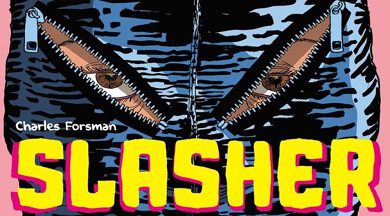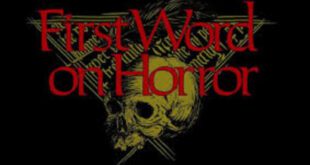I just finished up my third reading of writer/artist Charles Forsman’s graphic novel, Slasher (Floating World Comics 2018), and I’m honestly not sure the narrative completely works. I’m also not sure I care, as it adds to the queasy disorientation of the piece. I can legitimately say it’s one of my favorite comics to have been released within the last five years, regardless of whether or not it ends up being somewhat incoherent.
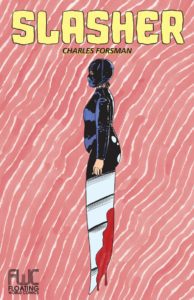
You may recognize Forsman’s name from the two series he’s had on Netflix, both adapted from his original graphic novels. The first, The End of the Fucking World, was successful enough that it earned a second season that went beyond the story told in the source work. The second, I Am Not Okay With This, seemed poised to do the same thing but it was recently cancelled, a casualty of the pandemic. Slasher fits right in thematically with those more well known efforts in that it features alienated misfits, bloody violence, and a quirky attitude. There are a few differences, though. Both of the other books are also notably melancholy with downbeat endings, but Slasher is much grimmer. Forsman also uses a more grotesque and realistic art style here, which works in evoking a heavier tone.
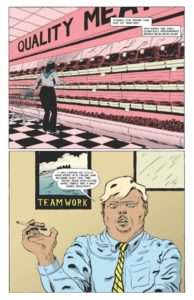
Our lead is Christine, an office worker with some concealed desires bubbling beneath the surface. The opening sees her dealing with a work review wherein her creepy lecherous boss gets a little too handsy. Though clearly repulsed, she buries her anger and disgust. During the meeting, she visualizes her boss’ face as a package of meat. It’s an interesting visual that comes across as more than a little surreal, but it also suggests that maybe everything that we’re about to see may not be explicitly real.
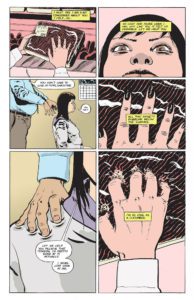
We soon discover that Christine has a thing for eating fistfuls of raw meat, but that’s not the only concerning aspect of her mental state. She seems to be carrying on an online relationship of sorts with a sickly young teenager named Josh. They’ve never met in person, but they connected through the knife fetish videos Josh posted of himself on a porn site. They converse via text messages where Christine discovers that Josh’s mother is abusive and delusional. His mom is in the mold of Margaret White from Carrie (1976 – read our retro review here) and is likely responsible for his condition.
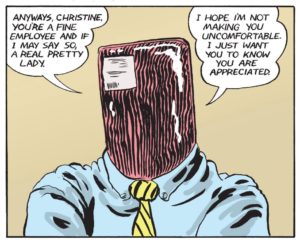
After the unexpected death of her father and with the situation being complicated by her mother’s alcoholism, Christine gives in to her darker urges. Fed up with the relentless tide of sleazy men trying to bed her, she’s ready to draw blood. She derives sexual satisfaction from this violence, so it’s not long until the murders start.
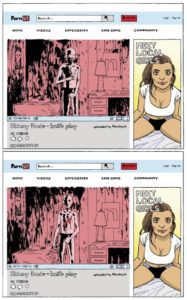
Originally published serially as a five issue series, something happens in the beginning of the fourth chapter that some readers may not feel is earned. I’m being vague to avoid spoilers, but this is what I was speaking about up top. It feels like a cheat to a certain extent, but we are dealing with a mentally unstable character, and we see events specifically through her perspective on more than one occasion. It’s a plot mechanics detail that feels purposeful, but on its surface, is inconsistent with what we’ve seen up to that point. In any case, for me it blends in with all the other bizarre happenings in the story.
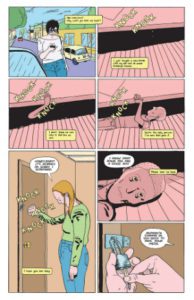
Beyond that structural nitpick, Forsman’s writing is strong. The cast isn’t really expansive, but his character work is vivid. Christine is deeply flawed and eventually reprehensible, but we feel for her. Even if she’s beyond morally compromised, she feels authentic. Josh’s pain is also palpable, and while his outlets are obviously unhealthy, we understand his rebellious attitude. If you said there weren’t any likable characters in the story, I can’t say I’d disagree. However, in this instance, I wouldn’t say that unlikable can’t also be compelling.
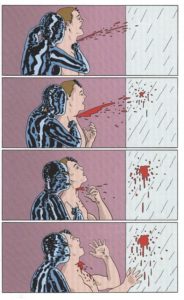
As I stated above, Forsman’s art in Slasher isn’t traditionally clean or pleasing here. In fact, it’s downright ugly at times. This isn’t a story about the beauty of humanity, though, and so I think it’s more than fitting. It’s very emotional work with an emphasis on imperfect faces. It’s my inkling that faces are so emphasized in order to make that connection to the reader, so they’re not turned off by the violence performed by our lead, which in turn heightens its impact. Figure work is distinctive, and Forsman’s clear storytelling allows for an easy read. The coloring plays a huge part in the atmosphere with a flat but rich palette making for nightmarish visuals.

Charles Forsman’s Slasher doesn’t play by the rules, and that extends to its structure. My advice is that if this sounds intriguing to you, then give it a shot and accept that the moment I mentioned is merely another part of the confusion that is part and parcel to the story’s strange motifs. It’s an unconventional comic that should appeal to folks who themselves are a little rough around the edges. Slasher isn’t a book that’s for the faint of heart as it dives headfirst into dark and filthy waters. Recommended for fans of gimp costumes, getting even with scumbag bosses, and uncompromising comics.
 PopHorror Let's Get Scared
PopHorror Let's Get Scared
